
Cirkit Designer
Your all-in-one circuit design IDE
Home /
Component Documentation
How to Use 5v 3A Li-ion Fast Charging Module: Examples, Pinouts, and Specs
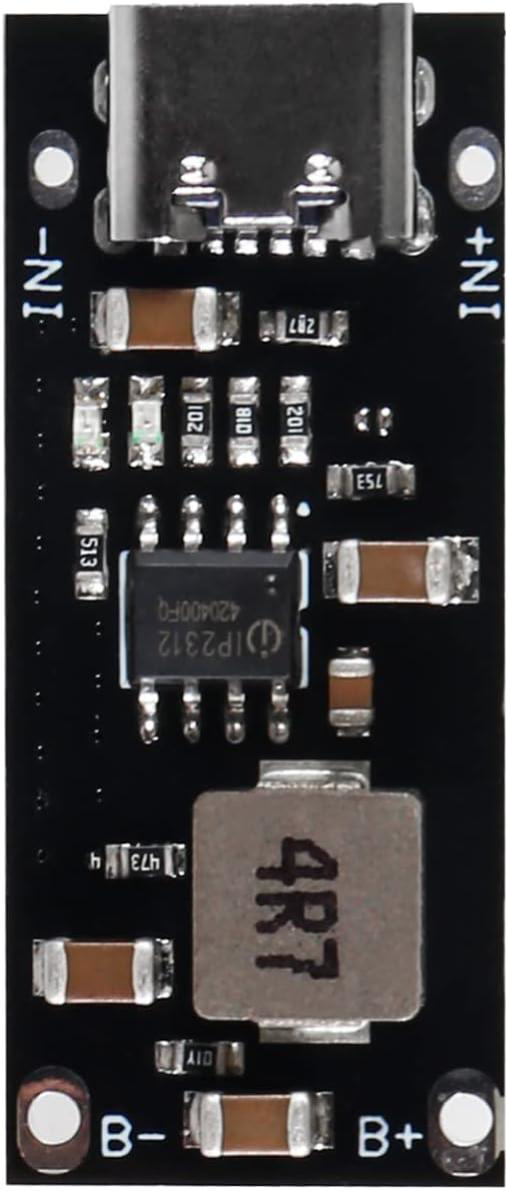
 Design with 5v 3A Li-ion Fast Charging Module in Cirkit Designer
Design with 5v 3A Li-ion Fast Charging Module in Cirkit DesignerIntroduction
The 5V 3A Li-ion Fast Charging Module by AITIAO (Part ID: Black) is a versatile and efficient charging solution designed for lithium-ion batteries. This module provides a stable 5V output and can deliver up to 3A of current, making it ideal for fast charging applications. It is commonly used in portable electronics, DIY projects, and any application requiring efficient battery management.
Explore Projects Built with 5v 3A Li-ion Fast Charging Module
Battery-Powered 18650 Li-ion Charger with USB Output and Adjustable Voltage Regulator
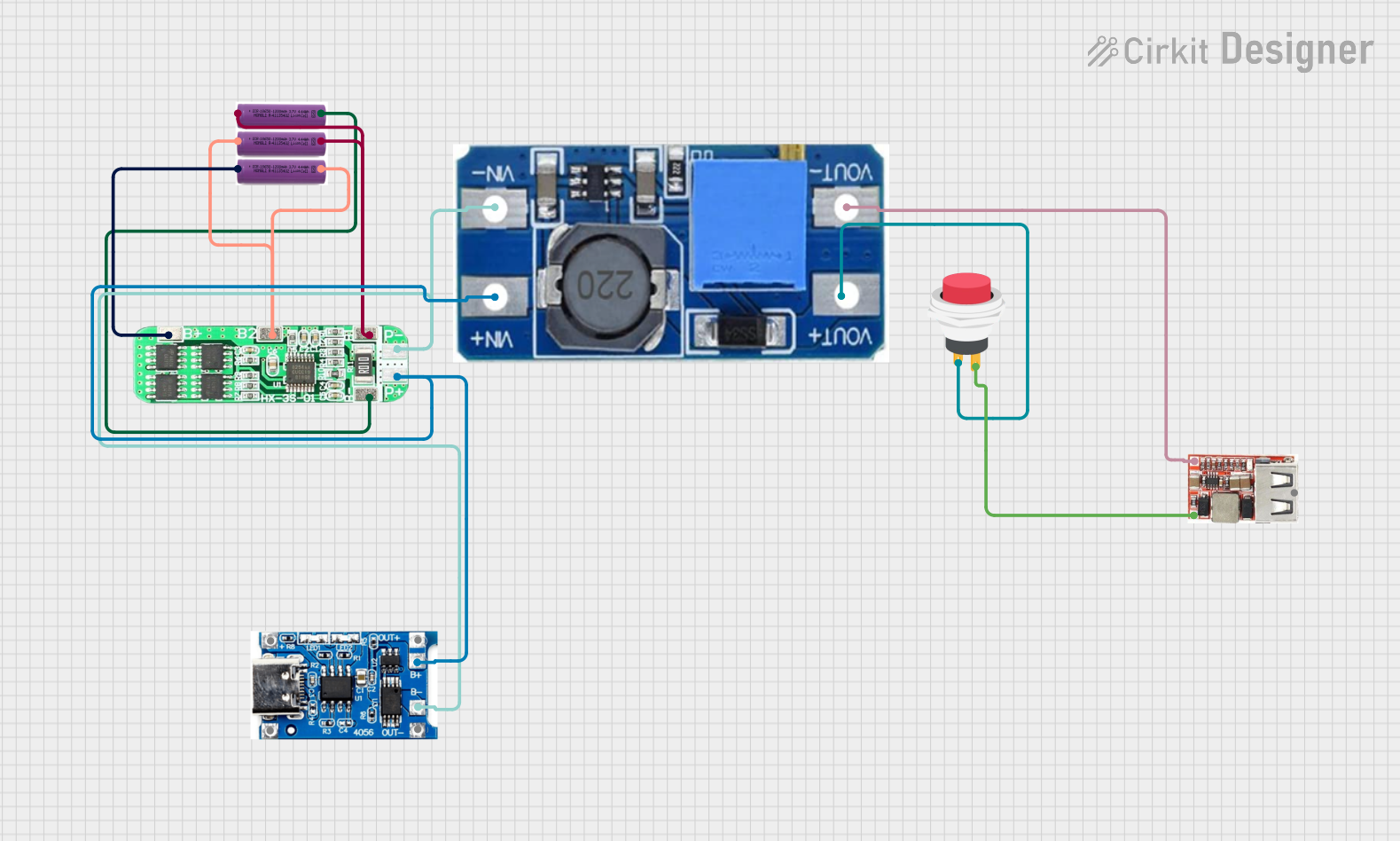
This circuit is a battery management and power supply system that uses three 3.7V batteries connected to a 3S 10A Li-ion 18650 Charger Protection Board Module for balanced charging and protection. The system includes a TP4056 Battery Charging Protection Module for additional charging safety, a Step Up Boost Power Converter to regulate and boost the voltage, and a USB regulator to provide a stable 5V output, controlled by a push switch.
 Open Project in Cirkit Designer
Open Project in Cirkit DesignerBattery-Powered Lora G2 Node Station with 18650 Li-ion Batteries and Boost Converter
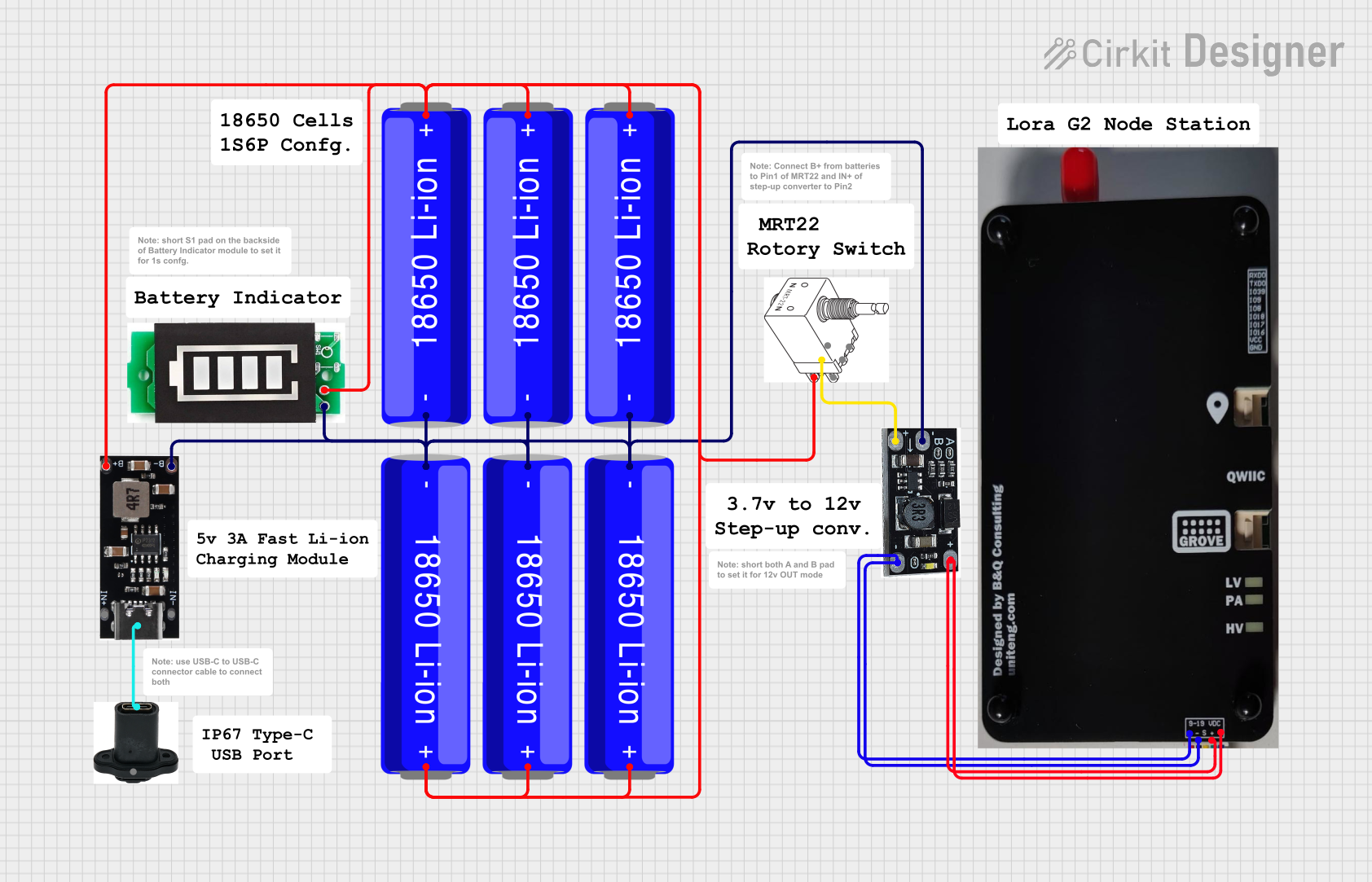
This circuit is a portable power supply system that uses multiple 18650 Li-ion batteries to provide a stable 5V output through a boost converter. It includes a fast charging module with a USB-C input for recharging the batteries and a battery indicator for monitoring the battery status. The system powers a Lora G2 Node Station, making it suitable for wireless communication applications.
 Open Project in Cirkit Designer
Open Project in Cirkit Designer3S 18650 Battery Pack with Protection Board for Safe Charging
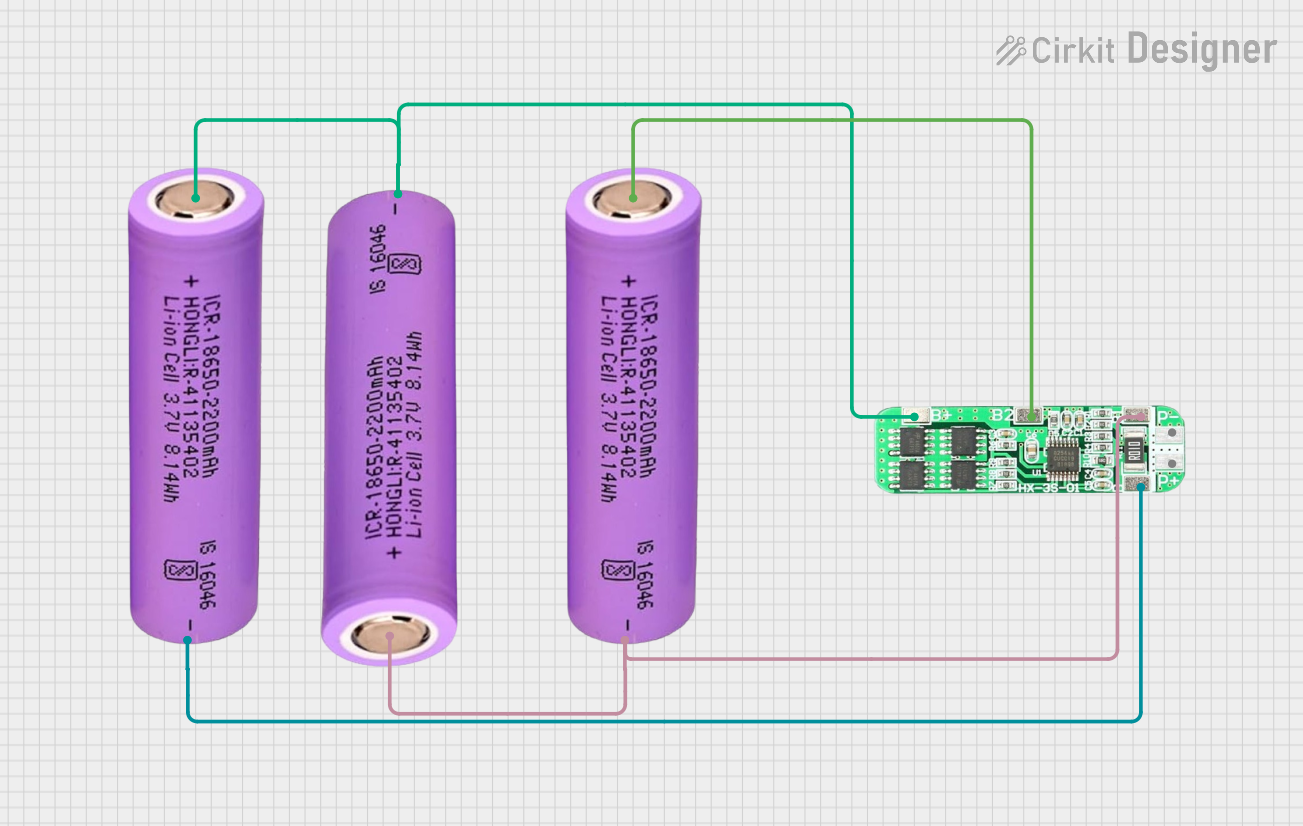
This circuit consists of three 18650 batteries connected in series to a 3S 10A Li-ion 18650 Charger Protection Board Module. The protection board manages the charging and discharging of the battery pack, ensuring safe operation by balancing the cells and providing overcharge, over-discharge, and short-circuit protection.
 Open Project in Cirkit Designer
Open Project in Cirkit DesignerBattery-Powered Audio Playback and Amplification System
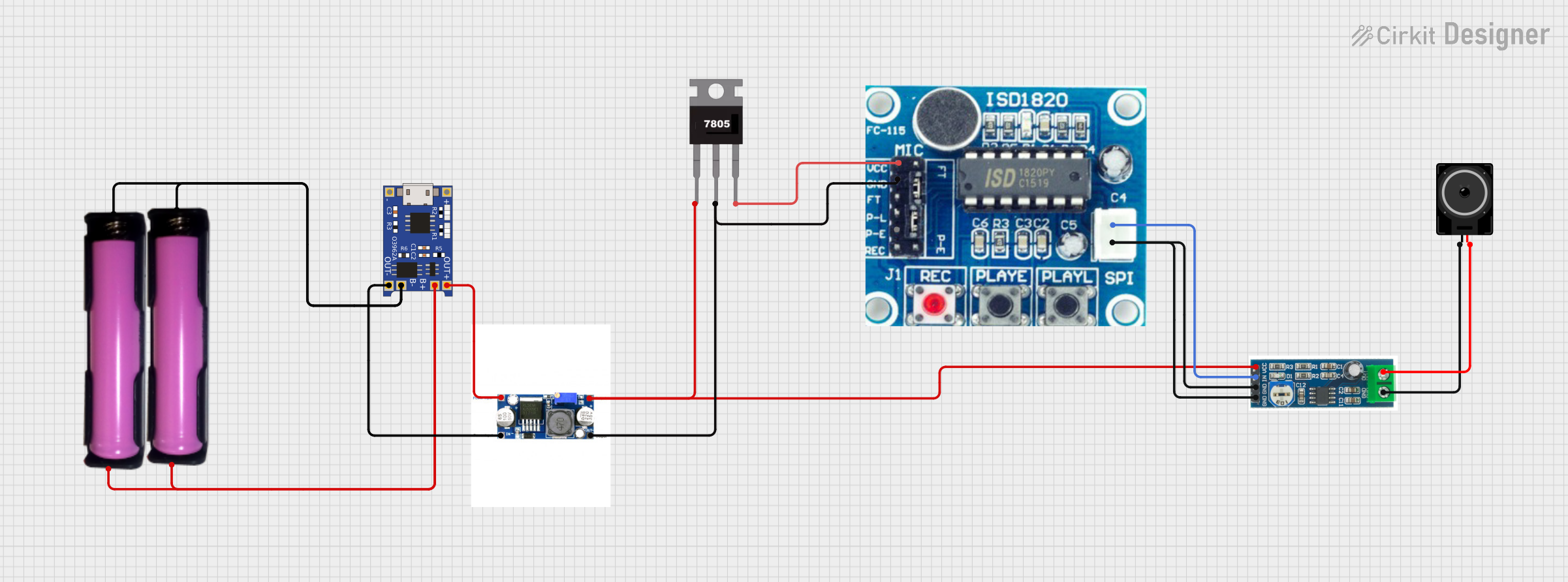
This circuit is designed to charge 18650 lithium-ion batteries using a TP4056 charger module, and then boost the voltage using an XL 6009 Boost Module. The boosted voltage is regulated by a 7805 voltage regulator to provide a stable 5V output, which powers an ISD1820 voice recording and playback module. The audio signal from the ISD1820 is then amplified by an LM386 audio amplifier module and output through a loudspeaker.
 Open Project in Cirkit Designer
Open Project in Cirkit DesignerExplore Projects Built with 5v 3A Li-ion Fast Charging Module

Battery-Powered 18650 Li-ion Charger with USB Output and Adjustable Voltage Regulator
This circuit is a battery management and power supply system that uses three 3.7V batteries connected to a 3S 10A Li-ion 18650 Charger Protection Board Module for balanced charging and protection. The system includes a TP4056 Battery Charging Protection Module for additional charging safety, a Step Up Boost Power Converter to regulate and boost the voltage, and a USB regulator to provide a stable 5V output, controlled by a push switch.
 Open Project in Cirkit Designer
Open Project in Cirkit Designer
Battery-Powered Lora G2 Node Station with 18650 Li-ion Batteries and Boost Converter
This circuit is a portable power supply system that uses multiple 18650 Li-ion batteries to provide a stable 5V output through a boost converter. It includes a fast charging module with a USB-C input for recharging the batteries and a battery indicator for monitoring the battery status. The system powers a Lora G2 Node Station, making it suitable for wireless communication applications.
 Open Project in Cirkit Designer
Open Project in Cirkit Designer
3S 18650 Battery Pack with Protection Board for Safe Charging
This circuit consists of three 18650 batteries connected in series to a 3S 10A Li-ion 18650 Charger Protection Board Module. The protection board manages the charging and discharging of the battery pack, ensuring safe operation by balancing the cells and providing overcharge, over-discharge, and short-circuit protection.
 Open Project in Cirkit Designer
Open Project in Cirkit Designer
Battery-Powered Audio Playback and Amplification System
This circuit is designed to charge 18650 lithium-ion batteries using a TP4056 charger module, and then boost the voltage using an XL 6009 Boost Module. The boosted voltage is regulated by a 7805 voltage regulator to provide a stable 5V output, which powers an ISD1820 voice recording and playback module. The audio signal from the ISD1820 is then amplified by an LM386 audio amplifier module and output through a loudspeaker.
 Open Project in Cirkit Designer
Open Project in Cirkit DesignerCommon Applications and Use Cases
- Portable Electronics: Smartphones, tablets, and other handheld devices.
- DIY Projects: Custom battery packs, robotics, and IoT devices.
- Battery Management Systems: Ensuring safe and efficient charging of lithium-ion batteries.
- Power Banks: High-capacity power storage solutions.
Technical Specifications
Key Technical Details
| Parameter | Value |
|---|---|
| Input Voltage | 5V |
| Output Voltage | 5V |
| Maximum Output Current | 3A |
| Charging Method | Constant Current/Constant Voltage (CC/CV) |
| Efficiency | Up to 95% |
| Operating Temperature | -20°C to 85°C |
| Dimensions | 25mm x 20mm x 5mm |
Pin Configuration and Descriptions
| Pin Number | Pin Name | Description |
|---|---|---|
| 1 | IN+ | Positive input voltage (5V) |
| 2 | IN- | Negative input voltage (Ground) |
| 3 | OUT+ | Positive output voltage (5V) |
| 4 | OUT- | Negative output voltage (Ground) |
| 5 | B+ | Positive terminal for battery connection |
| 6 | B- | Negative terminal for battery connection |
| 7 | CHG | Charging status indicator (active low) |
| 8 | DONE | Charge complete indicator (active low) |
Usage Instructions
How to Use the Component in a Circuit
Power Supply Connection:
- Connect the IN+ pin to a stable 5V power supply.
- Connect the IN- pin to the ground of the power supply.
Battery Connection:
- Connect the B+ pin to the positive terminal of the lithium-ion battery.
- Connect the B- pin to the negative terminal of the lithium-ion battery.
Output Connection:
- Connect the OUT+ pin to the positive terminal of the load.
- Connect the OUT- pin to the ground of the load.
Status Indicators:
- The CHG pin will be active low (0V) when the battery is charging.
- The DONE pin will be active low (0V) when the battery is fully charged.
Important Considerations and Best Practices
- Heat Dissipation: Ensure adequate ventilation or heat sinking to prevent overheating.
- Input Voltage: Use a stable 5V power supply to avoid damaging the module.
- Battery Compatibility: Only use with compatible lithium-ion batteries to ensure safety and efficiency.
- Polarity: Double-check connections to avoid reverse polarity, which can damage the module.
Example Circuit with Arduino UNO
/*
* Example code to monitor the charging status of the 5V 3A Li-ion Fast Charging
* Module using an Arduino UNO.
*/
const int chgPin = 2; // Pin connected to CHG status indicator
const int donePin = 3; // Pin connected to DONE status indicator
void setup() {
pinMode(chgPin, INPUT);
pinMode(donePin, INPUT);
Serial.begin(9600);
}
void loop() {
int chgStatus = digitalRead(chgPin);
int doneStatus = digitalRead(donePin);
if (chgStatus == LOW) {
Serial.println("Battery is charging...");
} else if (doneStatus == LOW) {
Serial.println("Battery is fully charged.");
} else {
Serial.println("Battery is not connected or already charged.");
}
delay(1000); // Check status every second
}
Troubleshooting and FAQs
Common Issues Users Might Face
Module Overheating:
- Solution: Ensure proper ventilation and consider adding a heat sink.
No Output Voltage:
- Solution: Check input voltage and connections. Ensure the power supply is stable and within the specified range.
Battery Not Charging:
- Solution: Verify battery connections and ensure the battery is compatible with the module.
Incorrect Status Indication:
- Solution: Check the connections to the status indicator pins and ensure they are correctly interfaced with the monitoring system.
Solutions and Tips for Troubleshooting
- Double-Check Connections: Ensure all connections are secure and correctly oriented.
- Use a Multimeter: Measure input and output voltages to verify proper operation.
- Monitor Temperature: Keep an eye on the module's temperature during operation to prevent overheating.
- Consult the Datasheet: Refer to the manufacturer's datasheet for detailed technical information and guidelines.
By following this documentation, users can effectively integrate the 5V 3A Li-ion Fast Charging Module into their projects, ensuring efficient and safe battery charging.